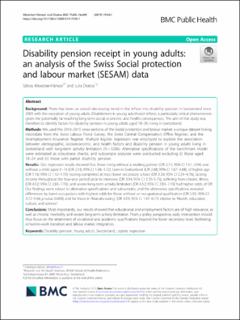Please use this identifier to cite or link to this item:
https://doi.org/10.21256/zhaw-3193Full metadata record
| DC Field | Value | Language |
|---|---|---|
| dc.contributor.author | Altwicker-Hámori, Szilvia | - |
| dc.contributor.author | Dratva, Julia | - |
| dc.date.accessioned | 2019-07-04T10:23:27Z | - |
| dc.date.available | 2019-07-04T10:23:27Z | - |
| dc.date.issued | 2019-06-26 | - |
| dc.identifier.issn | 1471-2458 | de_CH |
| dc.identifier.uri | https://digitalcollection.zhaw.ch/handle/11475/17402 | - |
| dc.description.abstract | Background: There has been an overall decreasing trend in the inflow into disability pension in Switzerland since 2003 with the exception of young adults. Disablement in young adulthood reflects a particularly critical phenomenon given the potentially far-reaching long-term social, economic and health consequences. The aim of this study was therefore to identify factors for disability pension in young adults aged 18–39, living in Switzerland. Methods: We used the 2010–2015 cross-sections of the Social protection and labour market; a unique dataset linking microdata from the Swiss Labour Force Survey, the Swiss Central Compensation Office Register, and the Unemployment Insurance Register. Multiple logistic regression was employed to explore the association between demographic, socioeconomic, and health factors and disability pension in young adults living in Switzerland with long-term activity limitation (N = 5306). Alternative specifications of the benchmark model were estimated as robustness checks; and subsample analyses were conducted excluding (i) those aged 18-24 and (ii) those with partial disability pension. Results: Our regression results showed that those living without a working partner (OR 2.11; 95% CI 1.51–2.94) and without a child aged 0–14 (OR 2.15; 95% CI 1.48–3.12), born in Switzerland (OR 2.68; 95% CI 1.87–3.84), of higher age (OR 1.16; 95% CI 1.12–1.19), having completed at most lower secondary school (OR 3.26; 95% CI 2.24–4.76), lacking income throughout the four-year period prior to interview (OR 3.94; 95% CI 2.70–5.75), suffering from chronic illness (OR 4.52; 95% CI 2.83–7.19), and severe long-term activity limitation (OR 4.52; 95% CI 2.83–7.19) had higher odds of DP. Our findings were robust to alternative specifications and subsamples; and the alternative specifications revealed differences by learnt occupation, with highest odds for those without an occupational qualification (OR 5.93; 95% CI 3.72–9.46; p-value 0.000) and for those in ‘Manufacturing’ (OR 3.59; 95% CI 1.91–6.71) relative to ‘Health, education, culture, and science’. Conclusions: Most importantly, our results showed that educational and employment factors are of high relevance, as well as chronic morbidity and severe long-term activity limitation. From a policy perspective, early intervention should thus focus on the attainment of vocational and academic qualifications beyond the lower secondary level, facilitating school-to-work transition and labour market integration. | de_CH |
| dc.language.iso | en | de_CH |
| dc.publisher | BioMed Central | de_CH |
| dc.relation.ispartof | BMC Public Health | de_CH |
| dc.rights | http://creativecommons.org/licenses/by/4.0/ | de_CH |
| dc.subject | Disability pension | de_CH |
| dc.subject | Young adult | de_CH |
| dc.subject | Switzerland | de_CH |
| dc.subject | Logistic regression | de_CH |
| dc.subject.ddc | 360: Soziale Probleme und Sozialversicherungen | de_CH |
| dc.title | Disability pension receipt in young adults : an analysis of the Swiss social protection and labour market (SESAM) data | de_CH |
| dc.type | Beitrag in wissenschaftlicher Zeitschrift | de_CH |
| dcterms.type | Text | de_CH |
| zhaw.departement | Gesundheit | de_CH |
| zhaw.organisationalunit | Institut für Public Health (IPH) | de_CH |
| dc.identifier.doi | 10.21256/zhaw-3193 | - |
| dc.identifier.doi | 10.1186/s12889-019-7098-1 | de_CH |
| zhaw.funding.eu | No | de_CH |
| zhaw.issue | 831 | de_CH |
| zhaw.originated.zhaw | Yes | de_CH |
| zhaw.publication.status | publishedVersion | de_CH |
| zhaw.volume | 19 | de_CH |
| zhaw.publication.review | Open peer review | de_CH |
| zhaw.funding.zhaw | Risikofaktoren einer Invalidisierung bei jungen Erwachsenen | de_CH |
| Appears in collections: | Publikationen Gesundheit | |
Files in This Item:
| File | Description | Size | Format | |
|---|---|---|---|---|
| s12889-019-7098-1.pdf | 726.23 kB | Adobe PDF |  View/Open |
Show simple item record
Altwicker-Hámori, S., & Dratva, J. (2019). Disability pension receipt in young adults : an analysis of the Swiss social protection and labour market (SESAM) data. BMC Public Health, 19(831). https://doi.org/10.21256/zhaw-3193
Altwicker-Hámori, S. and Dratva, J. (2019) ‘Disability pension receipt in young adults : an analysis of the Swiss social protection and labour market (SESAM) data’, BMC Public Health, 19(831). Available at: https://doi.org/10.21256/zhaw-3193.
S. Altwicker-Hámori and J. Dratva, “Disability pension receipt in young adults : an analysis of the Swiss social protection and labour market (SESAM) data,” BMC Public Health, vol. 19, no. 831, Jun. 2019, doi: 10.21256/zhaw-3193.
ALTWICKER-HÁMORI, Szilvia und Julia DRATVA, 2019. Disability pension receipt in young adults : an analysis of the Swiss social protection and labour market (SESAM) data. BMC Public Health. 26 Juni 2019. Bd. 19, Nr. 831. DOI 10.21256/zhaw-3193
Altwicker-Hámori, Szilvia, and Julia Dratva. 2019. “Disability Pension Receipt in Young Adults : An Analysis of the Swiss Social Protection and Labour Market (SESAM) Data.” BMC Public Health 19 (831). https://doi.org/10.21256/zhaw-3193.
Altwicker-Hámori, Szilvia, and Julia Dratva. “Disability Pension Receipt in Young Adults : An Analysis of the Swiss Social Protection and Labour Market (SESAM) Data.” BMC Public Health, vol. 19, no. 831, June 2019, https://doi.org/10.21256/zhaw-3193.
Items in DSpace are protected by copyright, with all rights reserved, unless otherwise indicated.